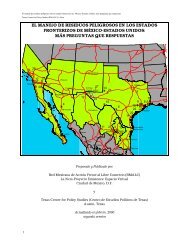Pesticides and Water Quality - Texas Center for Policy Studies
Pesticides and Water Quality - Texas Center for Policy Studies
Pesticides and Water Quality - Texas Center for Policy Studies
You also want an ePaper? Increase the reach of your titles
YUMPU automatically turns print PDFs into web optimized ePapers that Google loves.
2. <strong>Pesticides</strong> inDrinking <strong>Water</strong><strong>Pesticides</strong> most frequentlydetected in <strong>Texas</strong> drinkingwater systems: atrazine,metolachlor, simazine,alachlor. Of these, atrazineis by far the most frequentlydetected. Only one system,however, has been found tobe in violation of the federaldrinking water st<strong>and</strong>ard <strong>for</strong>atrazine since 1993, <strong>and</strong> thatsystem is now back incompliance.Some drinking water systems,primarily those using groundwater, have waivers frompesticidetestingrequirements. These waiversare granted only after a“vulnerability assessment”by TNRCC staff determinesthat the water source is notnor is it likely to becomecontaminated. TNRCC hasone of the mostcomprehensive vulnerabilityassessment programs in theU.S.We know more about the quality of our drinking water inrelation to pesticides. Through implementation offederal <strong>and</strong> state drinking water protection requirements,many water supply systems have been testing finisheddrinking water (i.e. water that is provided to the tap) <strong>for</strong>33 pesticides <strong>for</strong> which monitoring is required. Asdiscussed in more detail in this report, only a limitednumber of those systems conducting quarterly 8monitoring have detected pesticides in the drinking waterbeing provided to customers (at least 90 of over 5500systems). The fact that a pesticide is detected in the tapwater, however, is not the only consideration. Many ofthe pesticide detections have been at levels below the“maximum contaminant level” (MCL). In fact, to dateonly one system has been found to have violated thefederal drinking water st<strong>and</strong>ard (<strong>for</strong> atrazine). Aviolation of the st<strong>and</strong>ard occurs when the average of fourquarterly samples in exceeds the MCL.Atrazine—one of the herbicides most widely-used in<strong>Texas</strong>—is the most frequently detected pesticide indrinking water. TNRCC data indicate that between 1996<strong>and</strong> the first quarter of 1998, in 1,350 tests of publicdrinking water, atrazine was detected in 318 of the tests(about 25%). In the last few years, atrazine has beendetected in over 60 public water supply systems, servingat least 4 million people. In about 10% of the samples,atrazine exceeded the federal drinking water st<strong>and</strong>ard of3 parts per billion.As described in Appendix A, several systems in <strong>Texas</strong>have been granted “waivers” from the quarterlymonitoring requirements <strong>for</strong> pesticides or othercontaminants. Most waivers are granted <strong>for</strong> groundwater systems, as ground water systems are often lessvulnerable to contamination than surface water systems.These waivers are given after an analysis by TNRCCstaff of factors that affect the system’s vulnerability tocontamination—including well design <strong>and</strong> construction(<strong>for</strong> systems using ground water), geology <strong>and</strong> soils, l<strong>and</strong>use in the “zone of contribution” <strong>and</strong> prior drinkingwater monitoring results.8 I.e. monitoring once per quarter.7




